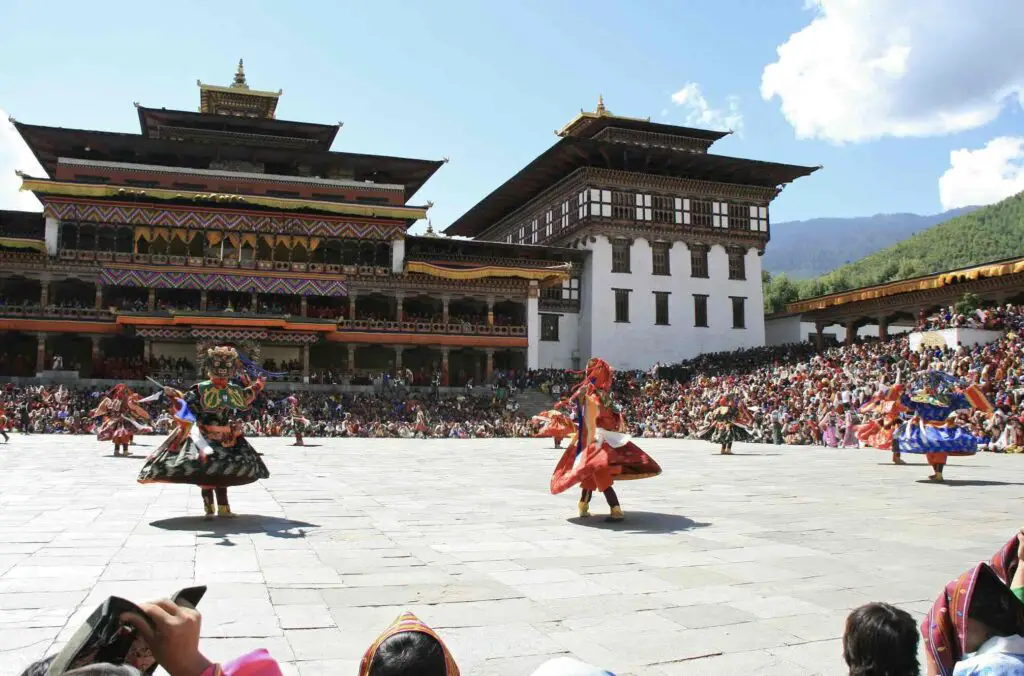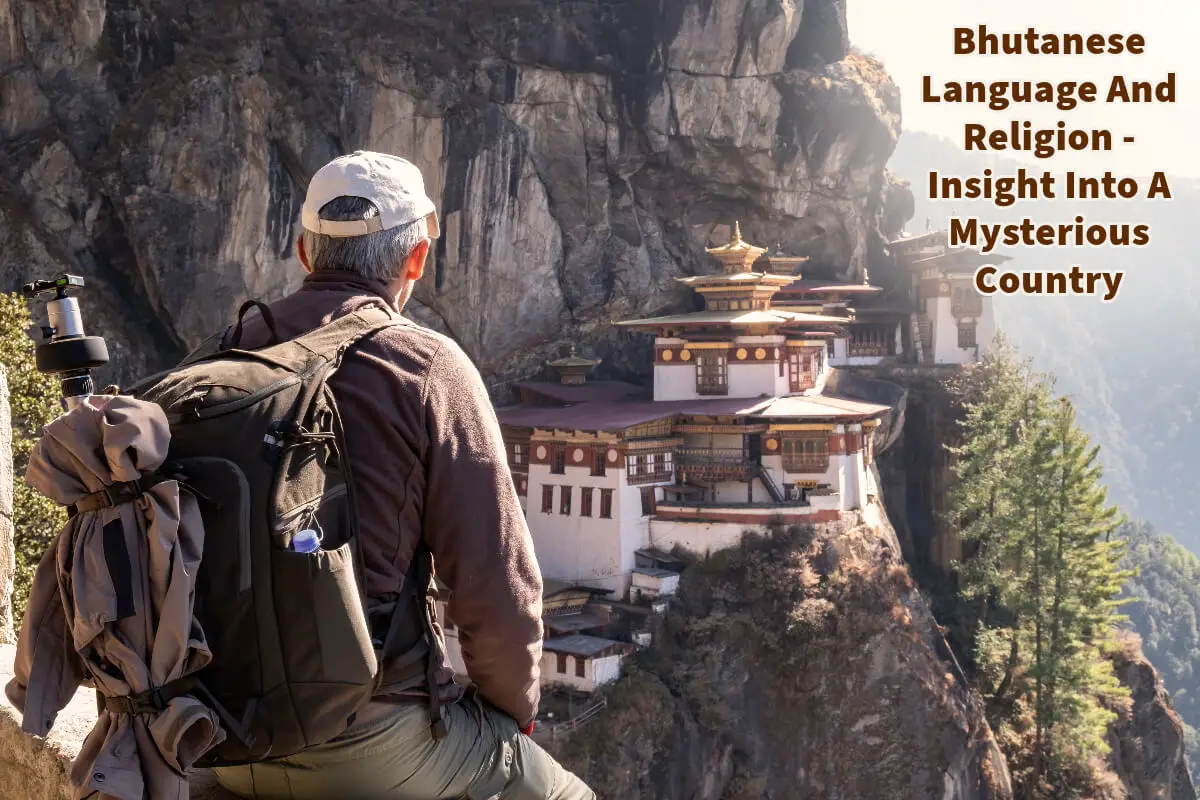Tucked away in the heart of the Himalayas, Bhutan remains an enigmatic realm, offering a fusion of its deep-rooted culture and abundant natural treasures. Its vast landscapes, heritage, and unique language and currency define its distinctive identity. Interestingly,
The main religion In Bhutan is Buddhism, and the primary language is Bhutan’s policy of selective tourism, which means not all foreigners get the privilege to explore this gem. Covering an area of 38,394 sq km, the Kingdom of Bhutan is reminiscent of the U.S. state of Indiana. Yet, it’s a world apart in its cultural richness and environmental splendor.
Table of Contents
- Bhutanese Language And Religion: An Insight Into The Heart Of The Thunder Dragon Kingdom
- 12 Facts About Bhutan’s Buddhism And Its Significance To The Bhutanese:
- Bhutan’s Buddhist Religion: Its Significance To The Nation And The Dzongkha Language
- Related Questions
Bhutanese Language And Religion: An Insight Into The Heart Of The Thunder Dragon Kingdom
Nestled between the majestic nations of China and India, Bhutan, officially recognized as The Kingdom of Bhutan, is a diminutive jewel that boasts unparalleled natural beauty and rich cultural heritage. Spread across an area of 38,394 sq km, it’s comparable to the U.S. state of Indiana.
With a climatic range that oscillates from tropical in the southern plains to the cool winters of central valleys and the chilly embrace of the Himalayas, Bhutan is a land of diverse landscapes. It boasts towering peaks like Kula Kangri, which stands at 7,553 m, and valleys like Brangme Chhu, resting at 97 m.
Bhutan, known as the Land of the Thunder Dragon, owes its title to the violent storms cascading from the Himalayas. The nation is also no stranger to frequent landslides during its rainy seasons and occasional earthquakes.
Despite its relatively small size, it’s home to a population of around 788,000, per 2023 records.
Diving into the mosaic of Bhutanese ethnicity, the Drukpa (including Sharchops) form 50% of the population. Additionally, ethnic Nepalese, termed Lhotsampas, account for 35%, with indigenous or migrant tribes constituting the remaining 15%.
Linguistically, Dzongkha shines as the official language, but English holds its ground firmly, especially in education. Other languages like Bumthang-kha, Sharchop-kha, and Nepali also find their voice among the Bhutanese.
Brief History Of Bhutan And Religion Explored
The Ngalops, believed to have Tibetan roots, made Bhutan their home around the 8th and 9th centuries A.D., introducing the nation to the tenets of Buddhism. Predominantly followers of the Drukpa Kagyupa school of Mahayana Buddhism, the Ngalops have played a pivotal role in shaping Bhutan’s governance and civil services.
Moreover, their cultural norms, as endorsed by the monarchy, serve as a guiding light for the entire nation.
The Sharchops, translating to “people of the east,” predominantly reside in Bhutan’s eastern regions. Considered the earliest inhabitants of Bhutan, they majorly follow the Ningmapa school of Mahayana Buddhism.
The combined populations of Ngalops, Sharchops, and the indigenous tribal people, grouped as Drukpas, make up roughly 65% of Bhutan’s populace.
Meanwhile, the Lhotsampas, of Nepali descent, form about 35% of Bhutan’s population. Having migrated during the 19th and 20th centuries, they primarily settled in the southern regions, engaging in agricultural activities.
Their linguistic leanings gravitate towards various Nepali dialects, and their faith predominantly aligns with Hindu traditions. But despite this Hindu population, Bhutan is considered a Buddhist country.
12 Facts About Bhutan’s Buddhism And Its Significance To The Bhutanese:
There is no doubt that Buddhism is central to the Bhutanese culture. Here are 12 significant points:

- Vajrayana Buddhism: Bhutan practices Vajrayana Buddhism, a form of Mahayana Buddhism. It is the state religion and an integral part of Bhutanese life.
- Guru Rinpoche: Bhutanese Buddhism holds Guru Rinpoche (Padmasambhava) in high regard. He is credited with introducing Buddhism to Bhutan in the 8th century and is often called the “Second Buddha.”
- Dzongs: Across Bhutan, fortresses known as Dzongs serve as administrative centers and monasteries, highlighting the blend of spiritual and temporal governance.
- Festivals: Tshechu, one of Bhutan’s grandest religious festivals, is celebrated in honor of Guru Rinpoche. Masked dances and traditional rituals during this festival seek blessings and ward off evil spirits.
- Prayer Flags: Dotting the landscape, colorful prayer flags are a common sight. They’re believed to spread goodwill and compassion, purifying the surrounding environment.
- Monastic Education: Many Bhutanese families send at least one son to monastic school, indicating religious education’s deep-rooted respect and significance.
- Phallus Symbols: Unique to Bhutan’s Buddhism, phallus symbols are painted on walls or hung outside houses. These symbols, inspired by the teachings of a saint named Drukpa Kunley, are believed to ward off evil and bring good luck.
- Meditation Retreats: It’s common for Bhutanese, including the youth, to spend time in retreat centers, isolated from society, engaging in meditation, and seeking spiritual enlightenment.
- Gross National Happiness: Buddhism’s principles directly influence Bhutan’s development philosophy of Gross National Happiness (GNH). GNH emphasizes holistic development and well-being over mere economic growth.
- Protection of Nature: Buddhism’s reverence for all living beings has shaped Bhutan’s environmental policies. The nation aims to balance development and conservation, with over 70% forest cover.
- Monks and Governance: Monks play a pivotal role not only in religious practices but also in governance. They have representation in Bhutan’s National Council, ensuring that decisions align with Buddhist principles.
- Daily Life: Buddhism in Bhutan is not just confined to monasteries. It’s evident in daily activities, from morning prayers to consulting religious calendars for auspicious dates.
Importance Of Buddhism To The Bhutanese:
Buddhism is the lifeblood of Bhutanese culture and identity. It offers a moral compass, guiding daily life, festivals, governance, and international policies. The teachings of Buddhism promote peace, compassion, and respect for all living beings, making it a harmonizing force in the lives of the Bhutanese.
Furthermore, Buddhism’s emphasis on contentment and inner peace resonates with the nation’s vision of Gross National Happiness, making the religion a spiritual path and a blueprint for holistic and sustainable development.
Religion, much like language, holds a mirror to Bhutan’s soul. Lamaistic Buddhism envelops about 75% of the population, standing proud as the state religion. However, Hinduism, primarily influenced by Indian and Nepalese traditions, is practiced by about 25% of the population.
Bhutan’s Buddhist Religion: Its Significance To The Nation And The Dzongkha Language
Bhutan, the last remaining Vajrayana Buddhist kingdom in the world, is often depicted as a country where religion and culture are inseparable. This unique tapestry’s core is Buddhism, deeply intertwined with the national language, Dzongkha.

10 Points On Why Buddhism Is Essential To Bhutan:
- Historical Foundation: Introduced in the 7th century, Buddhism has shaped Bhutan’s history, politics, and identity.
- Monastic Governance: The Je Khenpo, the chief abbot, plays a pivotal role in the nation’s governance, reflecting the profound influence of Buddhism on state affairs.
- Cultural Festivals: Religious festivals like Tshechus celebrate Buddhist myths and legends, strengthening community bonds.
- Architectural Splendor: Bhutan’s landscape is dotted with dzongs (fortress monasteries) and chortens (stupas), testaments to its Buddhist heritage.
- Moral Compass: Buddhism provides the ethical and moral framework guiding Bhutanese daily life.
- Gross National Happiness: This unique developmental philosophy of Bhutan is deeply rooted in Buddhist principles, emphasizing collective well-being over material growth.
- Environmental Conservation: Buddhist respect for all sentient beings has influenced Bhutan’s commitment to maintaining at least 60% forest cover, reflecting its eco-conscious approach.
- Pilgrimage Sites: Sacred sites like Paro Taktsang (Tiger’s Nest) attract thousands of pilgrims annually, reinforcing the nation’s spiritual character.
- Literary Heritage: Ancient Buddhist texts, manuscripts, and scriptures contribute significantly to Bhutan’s rich literary tradition.
- National Identity: Buddhism fosters a unique Bhutanese identity, setting it apart from its neighbors and reinforcing national unity.

10 Points On Why Buddhism Is Essential To Rhe Dzongkha Language:
- Linguistic Origins: Dzongkha borrows heavily from Buddhist terminology, reflecting its profound spiritual influences.
- Scriptural Foundation: The Dzongkha script, Chhokey, is based on the Tibetan script and is used extensively in Buddhist scriptures.
- Monastic Education: Monasteries, central to Bhutan’s educational system, promote Dzongkha’s usage, ensuring continuity.
- Religious Chants: Buddhist rituals, prayers, and chants are predominantly in Dzongkha, emphasizing its sacred status.
- Literary Works: Many of Bhutan’s literary treasures, including poems, hymns, and tales, are grounded in Buddhist teachings and are penned in Dzongkha.
- Cultural Preservation: Dzongkha preserves and transmits Buddhist tales and legends across generations through oral traditions.
- Artistic Expressions: Traditional songs, dances, and dramas, often narrating Buddhist stories, employ Dzongkha as their primary medium.
- Spiritual Vocabulary: Many Dzongkha words have profound spiritual connotations, reflecting the language’s intrinsic connection to Buddhism.
- Teaching Medium: Buddhist principles taught in schools are primarily delivered in Dzongkha, reinforcing its importance in religious education.
- National Unity: As the lingua franca of Bhutan, Dzongkha, intertwined with Buddhism, promotes a unified national identity amidst a backdrop of linguistic diversity.
In essence, Buddhism and Dzongkha form the dual pillars of Bhutan’s unique cultural and spiritual identity, preserving its heritage and guiding its path forward in an ever-evolving world.
To truly understand Bhutan’s language and religion, one must delve deep into it. These aren’t just aspects of daily life; they’re threads that weave the intricate tapestry of Bhutan’s identity.
At A Bus On A Dusty Road, we talk about everything about travel, life, and ex-pat living. We are all about “Living Life As A Global Citizen.” We explore social, cultural, and economic issues and travel.
We would love to have you be part of our community. Sign up for our newsletter to keep up-to-date by clicking here. If you have any questions, you can contact me, Anita, by clicking here.
Listen to our Podcast called Dusty Roads. You can find it on all major podcast platforms. Try out listening to one of our podcasts by clicking here.
Subscribe to our A Bus On A Dusty Road YouTube Channel with great videos and information by clicking here.
Related Questions
How Similar Are The Chinese And Vietnamese Languages?
Vietnamese and Chinese are Asian languages though they come from different language families. Vietnamese and Chinese are both tonal languages and have similar sentence structures. They are monosyllabic languages, meaning that one word has one syllable, and several dialects are spoken.
By clicking here, you can discover How Similar Are The Chinese And Vietnamese Languages?
What Is The Official Language Of Hong Kong?
The official language of Hong Kong is Chinese and English. The residents of Hong Kong are native Cantonese Chinese speakers, so the official language is Cantonese Chinese. Many in Hong Kong can also speak Mandarin Chinese; many local Hong Kong residents prefer to speak Cantonese Chinese or English.
By clicking here, you can discover What Is The Official Language Of Hong Kong?
How Closely Related Are The Thai And Vietnamese Languages?
Thai and Vietnamese are both Asian-based languages, but despite being Asian-based, they are from different language family groups. Both Thai and Vietnamese are tonal languages and are analytic languages.
By clicking here, you can discover How Closely Related Are The Thai And Vietnamese Languages?

